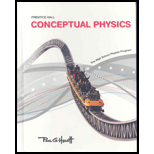
Concept explainers
A satellite TV company broadcasts its signals from its earthbound broadcast station to a satellite in geosynchronous orbit 36,000 km away and from there back to Earth’s surface.
a. How much time elapses between the time the signal leaves the station and the time it is received by someone’s satellite dish?
b. Explain why the answer doesn’t depend very much on exactly where the TV company and the customer are located on Earth.
(a)
To determine the time elapses between the time the signal leaves the station and the time received by someone’s satellite dish.
Answer to Problem 63A
The time elapse is 0.24s.
Explanation of Solution
Given data:
The length of signal is 2×36,000 Km = 72,000 Km = 72,000×1000 m.
Formula used:
Time elapsed,
Calculation:
We know that, the speed of light c =3×108m/s.
Substituting the values in the equation of time t is,
= 0.24 s.
The satellites boost the signal and send it back down to Earth from its transmitter to the receiver on the Earth. This process happens using radio waves, which travel at the same speed of light. So, it takes usually very little time for a few milliseconds only.
Conclusion:
The time elapse is 0.24seconds.
(b)
The time 0.24 seconds does not very much depend on the TV company and the customer.
Explanation of Solution
Introduction:
From the satellite link, the radio signal travels at 1.12×108 m to get the signal from the TV company to the customer. The light travels at 3×108m/s and we can notice half the second delay.
The Radio/TV signals are just small amounts of electricity that are at the right frequencies can travel in a usable footprint form the satellite. All the customers are within the footprint area of the company. The angle of the beam back to earth from the satellite will not be very large. The maximum angle is within the footprint area so the path is not large. This makes the signals transmit very efficiently. So, the time is not very much considerable.
Conclusion:
The delay in time for the radio signal is very small and does not depend on the TV company and the customer on the Earth.
Chapter 27 Solutions
Conceptual Physics: The High School Physics Program
Additional Science Textbook Solutions
Campbell Biology: Concepts & Connections (9th Edition)
Campbell Biology (11th Edition)
Campbell Essential Biology with Physiology (5th Edition)
Genetic Analysis: An Integrated Approach (3rd Edition)
Cosmic Perspective Fundamentals
Biology: Life on Earth (11th Edition)
- What fuel economy should be expected from a gasoline powered car that encounters a total of 443N of resistive forces while driving down the road? (Those forces are from air drag, rolling resistance and bearing losses.) Assume a 30% thermodynamic efficiency.arrow_forwardNo chatgpt pls will upvotearrow_forward12. What is the angle between two unit vectors if their dot product is 0.5?arrow_forward
- If the car in the previous problem increases its power output by 10% (by pressing the gas pedal farther down), at what rate will the car accelerate? Hint: Consider the net force. In the previous problem the power was 31.8kWarrow_forwardWhat power is required (at the wheels) for a 1400 kg automobile to climb a 4% grade at a constant speed 30 m/s while it is opposed by drag and rolling resistance forces totaling 500 N?arrow_forwardNo chatgpt pls will upvotearrow_forward
- As a box is lifted against gravity and placed on a shelf, how does the work done by the lifter compare with the work done by gravity? What is the net work done on the box? What does this imply about its change in kinetic energy? Use definitions and mathematics from this chapter to answer these questions.arrow_forwardAs I carry a box up a flight of stairs, am I doing positive work or negative work on the box? Provide a mathematical explanation.arrow_forwardAs a ball falls under the influence of gravity, does gravity do positive work or negative work? Provide a mathematical explanation.arrow_forward
 College PhysicsPhysicsISBN:9781305952300Author:Raymond A. Serway, Chris VuillePublisher:Cengage Learning
College PhysicsPhysicsISBN:9781305952300Author:Raymond A. Serway, Chris VuillePublisher:Cengage Learning University Physics (14th Edition)PhysicsISBN:9780133969290Author:Hugh D. Young, Roger A. FreedmanPublisher:PEARSON
University Physics (14th Edition)PhysicsISBN:9780133969290Author:Hugh D. Young, Roger A. FreedmanPublisher:PEARSON Introduction To Quantum MechanicsPhysicsISBN:9781107189638Author:Griffiths, David J., Schroeter, Darrell F.Publisher:Cambridge University Press
Introduction To Quantum MechanicsPhysicsISBN:9781107189638Author:Griffiths, David J., Schroeter, Darrell F.Publisher:Cambridge University Press Physics for Scientists and EngineersPhysicsISBN:9781337553278Author:Raymond A. Serway, John W. JewettPublisher:Cengage Learning
Physics for Scientists and EngineersPhysicsISBN:9781337553278Author:Raymond A. Serway, John W. JewettPublisher:Cengage Learning Lecture- Tutorials for Introductory AstronomyPhysicsISBN:9780321820464Author:Edward E. Prather, Tim P. Slater, Jeff P. Adams, Gina BrissendenPublisher:Addison-Wesley
Lecture- Tutorials for Introductory AstronomyPhysicsISBN:9780321820464Author:Edward E. Prather, Tim P. Slater, Jeff P. Adams, Gina BrissendenPublisher:Addison-Wesley College Physics: A Strategic Approach (4th Editio...PhysicsISBN:9780134609034Author:Randall D. Knight (Professor Emeritus), Brian Jones, Stuart FieldPublisher:PEARSON
College Physics: A Strategic Approach (4th Editio...PhysicsISBN:9780134609034Author:Randall D. Knight (Professor Emeritus), Brian Jones, Stuart FieldPublisher:PEARSON





